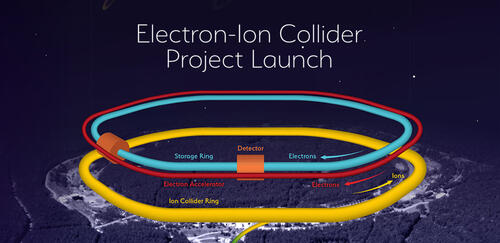
The U.S. Department of Energy’s (DOE) Brookhaven National Laboratory (BNL) in Long Island, New York, which has a strong research partnership with Yale, officially launched the next generation Electron-Ion Collider (EIC) at BNL on September 18, 2020. The EIC is a state-of-the-art research facility and partnership among the DOE, New York State, BNL, and the Thomas Jefferson National Accelerator Facility (Jefferson Lab) that will open a new frontier in nuclear physics; a field essential to our understanding of the visible universe with applications in national security, human health, and more.
According to the BNL press release, “DOE Under Secretary for Science Paul Dabbar, leaders from BNL and Jefferson Lab, and elected officials from New York State and Virginia today commemorated the start of the Electron-Ion Collider project. The event was an opportunity for in-person and virtual speakers to voice their support for this one-of-a-kind nuclear physics research facility, which will be built at Brookhaven Lab by a worldwide collaboration of physicists over the next decade.”
The release explains, “the 2.4-mile-circumference particle collider will act as a high-precision sub-atomic ‘microscope’ for exploring the innermost three-dimensional structures of protons and larger atomic nuclei. Experiments at the EIC will reveal how those particles’ fundamental building blocks (quarks and gluons) are arranged, how their interactions build up the mass of most of the visible matter in the universe and uncover the secrets of the strongest force in Nature. The journey into this new frontier in nuclear physics will attract the world’s best and brightest scientists, produce scientific and technological advances that extend to medicine and national security, and serve as a hub of innovation, collaboration, and STEM education for decades to come.”
The launch is especially welcomed by the Relativistic Heavy Ion Group (RHIG) at Wright Lab, led by professor of physics Helen Caines and D. Allan Bromley professor of physics John Harris. RHIG has been developing technologies for detectors at BNL for many years, and their expertise will be invaluable for designing and developing detectors for the EIC. Caines and Wright Lab adjunct professor Thomas Ullrich, who has been one of the key players in developing the EIC, said that there may also be opportunities for Yale researchers to get involved in the data and computing side of the EIC.
Caines said, “the facility is close; it is the natural progression of our group, and the next big thing in nuclear physics that we have very strong connections to.”
Read more about the EIC in the full BNL press release.

